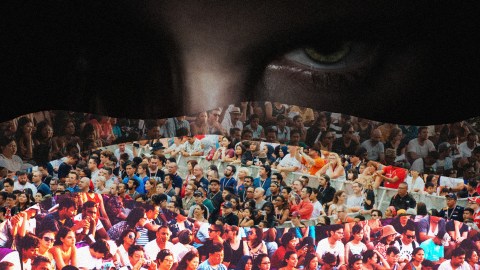Agenda 21, a wild conspiracy theory reignited by coronavirus

- The Agenda 21 conspiracy theory is spreading widely thanks to pandemic fears.
- The theory falsely claims the United Nations and governments are colluding to wipe out 90 percent of the global population.
- Agenda 21 is based on an actual UN resolution from 1992 and is aimed at the sustainability movement.
In an age drowning in conspiracy theories, Agenda 21, a tinfoil favorite that goes back to the ’90s has been reignited by the coronavirus. The gist – a totalitarian world cabal is trying to depopulate the planet by 90 percent and the U.N. is in on it. As are numerous governments (including yours). The reason for the conspiracy theory’s recent surge in shares and popularity? It can tie in vaccinations, Soros, Bill Gates, and 5G into a neat nexus of paranoid fantasies.
The conspiracy, spun out of a nonbinding UN resolution on sustainable development from 1992, actually envisions a whole New World Order that is supposedly being brought into existence by nefarious global operators. The “21” part of Agenda 21 refers to the target year of 2021 from the original UN plan. By now that goal post has been moved to 2030, by which date, the conspiracy claims, we would get a one-world government, subjugating the rest of the nations. The smörgåsbord of fears includes one world currency, one religion (if any), one military, no private property, no family units, mandatory vaccines, microchips for everyone, Social Credit System, 5G monitoring, and the government raising your children and controlling all the schools. People would not be able to own cars or businesses as everything will be managed either by corporations or governments.
Agenda 21, as it’s currently presented in social media on accounts with hundreds of thousands of followers, also attacks Universal Basic Income and purports people will be segregated into human settlement zones (a favorite of dystopian teenage fiction).
And there’d be no fossil fuels, a fact that doesn’t necessarily sound so bad, but is part of a hyperbolic list of horrible things that attacks the environmental movement and certain progressive goals.
Of course, some parts of the conspiracy may not sound too far-fetched to us, as they draw upon the tensions of our current societies and have grains of truth to them. But taken as a whole, Agenda 21 is a collection of unproven and unprovable attacks on reason and truth that was “being used by extremists and mainstream politicians to stoke fears and stifle rational policymaking across the country” as concluded a 2014 report by the Southern Policy Law Center (SPLC). The same can be said of today.
How to shut down coronavirus conspiracy theories | Michael Shermer | YouTube
As explained to BuzzFeed News by Heidi Beirich, who co-authored the SPLC report, “Fears are running rampant in the far right that [the coronavirus] is some part of a conspiracy, maybe by the Chinese government, other global actors, even George Soros, to do ‘something’ to conservatives or Americans.” What does this lead to? “It’s not surprising that Agenda 21 would pop up again in that environment,” thinks Beirich.
Lest you think only fringe elements can believe such a modern anxiety hodgepodge, these beliefs find their way into mainstream conversations, with Newt Gingrich, Senator Ted Cruz, and Glenn Beck (who wrote a book about it) bringing Agenda 21 up in their speeches. And the 2012 platform of the Republican Party stated flatly “we strongly reject the U.N. Agenda 21 as erosive of American sovereignty.”
Over the years, fears of Agenda 21 found their way into opposing efforts by local governments to promote resource and land conservation or build bike lanes or public transportation hubs. Real-world impact caused by oversized reactions to an agreement that SLPC described as “a feel-good guide that cannot force anyone, anywhere, to do anything at all.”
There is enough fertile ground for such ideas to spread, as evidenced by a published letter to the editor that maintains Agenda 21 wants to get the world population under 500 million. That means about 7 billion (or 90 percent of us) have to be eliminated somehow. And, of course, what better way than a pandemic?
The 1992 UN resolution that gave birth to this dangerous meme was a rather innocuous affair, not worthy of such continued attention. U.N. often comes across as a powerless and ineffectual organization and claims of such well-coordinated evil designs are highly farfetched. Of course, that’s what they want you to think.
As it explains on a page of the UN Division for Sustainable Development Goals website dedicated to Agenda 21, the document is a “comprehensive plan of action” that is supposed to be carried out at every level – global, national and local. It is to be undertaken by all the organizations that comprise the United Nations System as well as the leaders of nations. In fact, the signers at the United Nations Conference on Environment and Development (UNCED) held in Rio de Janerio in June 1992 included 178 governments.
The agreement was also to apply rather broadly to “major groups in every area” where humans impact the environment. The misinformation about Agenda 21 brings potential harm to millions of people, while the goals of the document itself are concerned with managing various types of waste, women’s health, public transportation and encouraging sustainability cooperation that should start at the local level to be successful.
As the coronavirus pandemic continues to ravage the globe, the wild spread of theories that will stop some people from taking necessary precautions, medicine, and eventual vaccines, is a tragic illness of its own.
Read the full text (comprised of 351 pages) of the Agenda 21 here.
Fascism and conspiracy theories: The symptoms of broken communication





